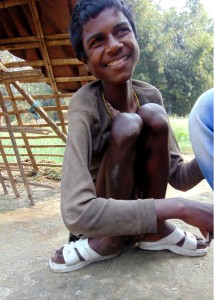 Quicklinks:
Quicklinks:
- Prevalence
- Poverty
- Education
- Transition to work and financial independence
- Employment
- Sex and relationships
- Acceptance
- Conclusion
- Resources
- Sources
Youth with disabilities are among the most marginalized and poorest of the world’s youth population and are more likely to face severe social, economic, and civic disparities as compared with those without disabilities, even in developed countries. For many young people with disabilities, exclusion, isolation, and abuse as well as lack of educational and economic opportunities are daily experiences (UNICEF, 2013).
The Convention on the Rights of Persons with Disabilities (CRPD) and with the 2030 Agenda for Sustainable Development are making strides towards the greater inclusion of youth with disabilities in society and development, as well as toward the realization of their human rights. As countries continue their efforts toward poverty reduction and equitable development, it is crucial that all youth are offered equal opportunities to participate in and contribute to society at all levels, which includes youth with disabilities.
Prevalence
There is a marked lack of empirical research on the prevalence of disabilities among the youth population. The estimated number of children with disabilities between 0 and 18 years ranges between 93 million and 150 million (UNICEF, 2013). These figures are rough estimates, however, and reflect the insufficiency of data on youth with disabilities, especially in the developing world.
Although the actual figures are uncertain, it is clear that individuals with disabilities form a significant proportion of the youth population in every society. The number of youth with disabilities is likely to increase due to the large youth populations in most developing countries and to medical advancements which promote higher survival rates and life expectancy after impairment-causing diseases, health conditions, and injuries. In fact, youth itself can be a contributing factor to disability as young people are at an increased risk of acquiring a disability through such incidents as road traffic accidents, injuries from diving and other sport activities, violence and warfare (Aito et al. 2005, Cripps 2003, Karacan et al. 2000).
In order to create a full body of research regarding youth with disabilities and inform future policy decisions, Article 31 of the CRPD requests that States Parties conduct research and collect much needed data on this under-researched population.
Poverty
While young people in general experience poverty at higher rates than their older counterparts, youth with disabilities are especially at risk of falling at or below the poverty line. Households including persons with disabilities often have lower incomes than those not affected by disability as family members may sacrifice wage-earning activities in order to take on care-giving roles at home (Mitra et al, 2011). Disabling conditions may be expensive for families to treat and accommodate, especially in areas where public resources is restricted or unavailable. Youth with disabilities may also face significant barriers to finding and and maintaining employment, especially employment that pays a living wage, increasing their collective risk of poverty.
The CRPD notes this crisis of poverty among persons with disabilities; Article 28 calls for the creation of poverty-reduction programs targeted at persons with disabilities and their families.
Education
Children with disabilities have lower probability of entering, staying or advancing in school than children without disabilities (World Health Organisation, 2011). Educational establishments are often inaccessible, lack appropriate facilities, or do not provide students with disabilities the accommodations or assistive devices necessary for their inclusion and academic success (UNESCO, 2015). By the time they enter adolescence, youth with disabilities run a high risk of being illiterate, leading to restricted opportunities for further education and employment (Eide & Kamaleri, 2009; Singal, Bhatti & Malik, 2011). Furthermore, sensitization, awareness-raising and capacity building programs and special education training designed to adequately prepare teachers and educators are sorely lacking. Youth with disabilities remain under-represented in higher education institutions across the globe, although numbers have recently been increasing in this arena in many countries (OECD, 2015).
Article 24 of the CRPD addresses these inequalities and seeks to ensure that persons with disabilities are included in the general education system and that individual supports and accommodations are provided to facilitate the development of their full potential.
Transition to work and financial independence
Many young persons with disabilities face a difficult period of upheaval and uncertainty as they transition from childhood into adulthood, primarily with regards to achieving successful employment and independent living. For youth with disabilities who may have experienced exclusion from their surrounding community, the transition to adulthood and independence can be particularly challenging. Social welfare programs may help youth with significant disabilities make the transition to independent living and adulthood, but such programs may be difficult to access or may be unavailable to youth living in remote or underserved communities (Padney, 2013). In developed countries, many youth with disabilities face a sharp drop-off in access to services upon reaching the age of majority. The sudden loss of individualized supports and services and the many barriers to seeking out, applying for, and acquiring appropriate accommodations can be difficult to overcome (National Council on Disability, 2000). Enhanced transitional services are needed to address this issue and provide young adults with disabilities with the supports needed to be successful on their own.
Employment
Unemployment rates for youth with disabilities are higher than for the rest of the youth population in every society (Mitra, Posarac & Vick, 2013). While inequities in education and vocational training resources can negatively impact the employment options available to persons with disabilities, negative attitudes about disability and discrimination based on disability status may also create significant barriers to long term, appropriately compensated employment. If employment is obtained, youth with disabilities are typically given little room for error and may labelled unemployable if they encounter struggles on the job. For young women with disabilities, the situation is even worse as they are forced to work against disability and gender based societal prejudices.
Article 27 of the CRPD stipulates that all persons with disabilities, including youth, have the right to work. To this end, many governments (local, regional and national) have implemented incentives for hiring persons with disabilities as part of efforts toward a more inclusive society.
Sex and Relationships
Access to information regarding reproductive health, HIV/AIDS, and human sexuality is often not available to youth with disabilities or may be disseminated through inaccessible means. This lack of information may have significant negative consequences as it deprives youth with disabilities of the tools needed to navigate sex and relationships safely and confidently. Additionally young persons with disabilities, especially young women, are much more likely than the population at large to experience sexual, physical and emotional violence (UNICEF, 2013).
Article 23 of the CRPD addresses these issues, asking that countries provide family planning and education to all individuals with disabilities on an equal basis with those without disabilities, including education regarding sexual health, relationships and reproductive health.
Acceptance
Young people with disabilities often experience rejection and seclusion due to peers’ misconceptions, or prejudices. Feelings of loneliness and isolation may be reinforced by activities and spaces that are inaccessible to persons w ith disabilities. Ignorance and misinformation about disability itself may contribute to feelings of isolation from peers. Youth programmes seldom address issues unique to youth with disabilities, include such individuals in their membership or seek out their participation. Greater awareness and understanding of disability is fundamental to improving the lived experience of young people with disabilities worldwide. Concerted efforts are needed to raise awareness and disseminate accurate information that challenges misconceptions and stereotypes about persons with disabilities. Designing accessible infrastructure and providing equal opportunities for youth with disabilities to participate in all aspects of youth development are equally important in promoting full participation and inclusion of the communities in which they live.
ith disabilities. Ignorance and misinformation about disability itself may contribute to feelings of isolation from peers. Youth programmes seldom address issues unique to youth with disabilities, include such individuals in their membership or seek out their participation. Greater awareness and understanding of disability is fundamental to improving the lived experience of young people with disabilities worldwide. Concerted efforts are needed to raise awareness and disseminate accurate information that challenges misconceptions and stereotypes about persons with disabilities. Designing accessible infrastructure and providing equal opportunities for youth with disabilities to participate in all aspects of youth development are equally important in promoting full participation and inclusion of the communities in which they live.
Conclusion
Youth with disabilities face the same issues and concerns as those without disabilities, but societal prejudices, barriers, and ignorance can complicate and intensify these concerns. To date, most societies have not fully integrated youth with disabilities, leading to the exclusion and isolation of a large and important segment of the population. Clearly, more work is required to create an integrated and equitable world for youth with disabilities. Providing opportunities for full and equal social, civic, economic, and political participation is beneficial not only to youth with disabilities, but also their surrounding societies, allowing youth to contribute fully to the country’s development and economic growth to fullest extent of their abilities.
The CRPD and the 2030 Agenda for Sustainable Development offer a plan for including all persons with disabilities in all aspects of society and development. The implementation and realization of this plan will require focused attention and effort by all stakeholders, especially Governments and policy makers, to ensure that the rights of persons with disabilities remain a priority and that all persons may exercise the same rights regardless of disability status.
- UNICEF Children with disabilities
- The State of the World's Children: Children with Disabilities (UNICEF, 2013)
- Children and Young People with Disabilities Fact Sheet. (UNICEF, May 2013)
- Leonard Cheshire Disability
- Lumos
- National Collaborative on Workforce and Disability
- MDRC Youth with Disabilities
Children and Young People with Disabilities Fact Sheet (UNICEF, 2013)
Education at a Glance (Organisation for Economic Co-operation and Development, OECD, 2015)
Transition to Adulthood for Youth with Disability: Issues for the Disabled Child and Family. (Sudha Pandey & Shalini Agarwal, 2013).
Education for All Global Monitoring Report: Achievements and Challenges 2000-2015 (UNESCO, 2015).
World Report on Disability and Development (World Health Organisation & World Bank, 2011)
Singal, N., Bhatti, F., & Malik, R. (2011). Counting the invisible: understanding the lives of young people with disabilities in Pakistan. Disability and Rehabilitation, 33(11), 908-921.
Be informed! Get involved! Please let us know if you have updates to the above information and/or additional resources that could help make this page more useful. Email us: enable@un.org
 Welcome to the United Nations
Welcome to the United Nations